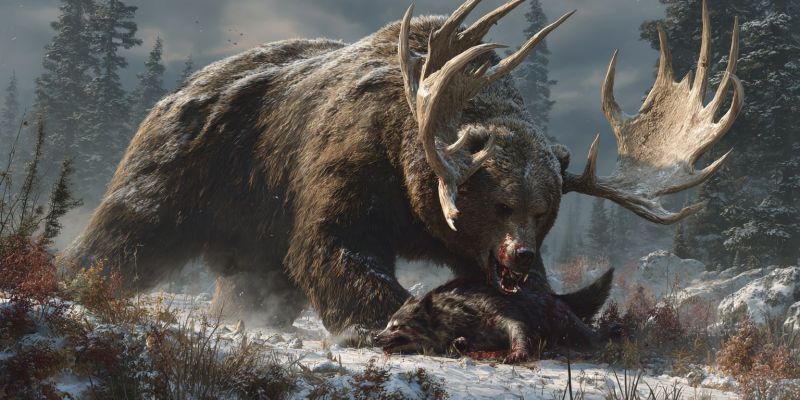 Natural Armor:
Natural Armor:-
Natural Armor +60 gp
 Natural Weapon(s):
Natural Weapon(s):-
Bite (3d10)
-
Claw (2d10)
-
Horns (d12)
 Abilities:
Abilities:-
Roar of the Forest Tyrant1000 gp
 Attack Abilities:
Attack Abilities:-
Charge (30ft) (3d6)4200 gp
 Monster Bits:
Monster Bits:-
540 Animal Blood0.1 gp
-
1350 Animal Bone0.03 gp
-
1350 Animal Fat0.5 gp
-
2700 Animal Meat0.05 gp
-
450 Soft Skin0.05 gp
Trees snap and earth quakes as a colossal bear with jagged horns bursts through the undergrowth, its matted fur bristling and breath steaming, radiating raw power and an insatiable, primal hunger.
The Horned Bear
Field Notes of Minner Nibbletuff, Naturalist and Unfortunate Expert on Things That Want to Eat Me
Introduction — “The Forest Tyrant”
Ah, where do I begin with this mountain of muscle and malice? The locals call it the Forest Tyrant, though its proper name—according to my trembling quill—is the Horned Bear. I’d call it a walking avalanche of fur, horn, and teeth. Imagine a bear the size of a merchant’s wagon, slap a pair of horns on its head that could gore a wyvern, and you’ll get the idea. It’s the kind of creature that makes even the trees try to grow legs and run for their lives.
I came here to study its habits. Instead, I’m writing my will on the back of this journal page.
Physical Description — “Built Like a Cathedral of Meat”
The Horned Bear’s fur isn’t your typical brown or black—no, it’s a shifting mix of dark greens, deep browns, and streaks of gray, like the forest floor itself learned how to breathe. Moss clings to its back, sometimes sprouting tiny mushrooms from the dried blood of past victims. Its horns, jagged and ridged like petrified roots, curve forward in cruel arcs, perfect for splitting a tree—or a skull—clean in half.
Each paw is the size of a shield, its claws thick and dark as obsidian blades. And when it exhales, the air fills with a damp, earthy stench, a mix of rotting leaves and the iron tang of old kills.
I once measured a footprint left in the mud—it was three feet across. I’ve since stopped measuring.
Behavior — “A Hunter of Habits and Hunger”
The Horned Bear isn’t a mindless brute. It’s patient. It watches. When the herds of Giant Elk migrate through the valley, the Forest Tyrant follows—never far behind, always downwind. It waits until the old or the young lag behind before it strikes with terrifying precision.
When the elk disappear, it doesn’t stop hunting. Wolves vanish next. Then boars. Then anything foolish enough to walk upright. It doesn’t hunt for sport—no, this beast hunts because hunger is the only god it knows.
I’ve observed it once from a distance—emphasis on once. It sat still for nearly an hour, the only movement being the slow twitch of its ears. Then, like a storm breaking, it charged forward, uprooting trees as if they were twigs. The sound alone nearly made me shed my fur.
Habitat — “Where the Forest Breathes, It Sleeps”
Horned Bears dwell in old-growth forests, where the trees grow thick and the canopy chokes out the light. They prefer valleys with rivers, where prey come to drink and leave footprints that reek of fear.
Their dens are enormous—collapsed trees woven into crude shelters, littered with bones and antlers. They mark territory not with scent, but with destruction: claw marks carved deep into stone, trees felled in lines like warnings, and the occasional half-eaten carcass displayed as a message.
If you find yourself in such a place, my advice is simple: walk backward, quietly, and reconsider your life choices.
Cultural Notes — “The Bear God and the Bloody Rite”
Among the Frostfang Tribes of the North, the Horned Bear is revered as the Spirit of Dominion. Warriors wear its teeth as charms and claim its roar calls the souls of the dead to battle. Ritual hunts are rare, and most end poorly. The few who survive—limbless or scarred—are seen as blessed by the Bear God’s mercy.
Other cultures speak of the Forest Tyrant as a curse—an omen of famine and death. When the beast roars, hunters say the forest itself shudders. Villages close their gates, and every flame is doused, for it’s said the creature’s eyes burn brightest when they catch the glow of firelight.
Encounters — “A Roar That Shakes the Bones”
The first sign isn’t sight—it’s sound. A low rumble that vibrates through the soil. Then the trees begin to sway though there’s no wind. And finally, it steps into view—massive, silent for its size, its horns scraping branches as it lowers its head.
When it roars, birds fall dead from the trees, their hearts bursting from the sheer force of the sound. It’s not merely a warning—it’s domination made audible.
I once thought myself brave enough to record that roar in writing. I was wrong. I wrote “RRRRGHHHHHH” and passed out halfway through.
Closing Notes — “If Found, Deliver Journal to My Next of Kin”
The Horned Bear is not just an animal—it’s the forest’s punishment made flesh. If I ever make it back to civilization, I’ll suggest renaming it something more accurate, like Run-for-Your-Life Beast or Saint Growl’s Nightmare.
Until then, I remain, hopefully alive,
—Minner Nibbletuff
Field Researcher, Guild of Curious Minds
Environment:
![]()
